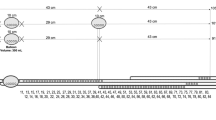Abstract
PURPOSE: This study was designed to determine whether functional variations of internal sphincter activity occur in order to differentiate between patients with anal fissures from those with hemorrhoids. METHODS: Thirty patients with chronic anal fissure (median age, 28 years; 12 females), 22 patients with hemorrhoids (median age, 37 years; 7 females), and 33 control volunteers (median age, 48.5 years; 21 females) underwent ambulatory anal sphincter fine-needle electromyography and anorectal manometry. RESULTS: The median internal sphincter electromyography frequency was similar: fissure group, 0.49 Hz; hemorrhoid group, 0.46 Hz (P>0.05), and control group, 0.44 Hz (P>0.05). Median anal resting pressures were similar in the fissure group (132 cm. H 2 O) and the hemorrhoids group (116 cm of H 2 O) (P>0.05), but significantly greater than those in the control group (94 cm. H 2 O) (P<0.05). The median number of transient relaxations of the internal anal sphincter with an associated rise in rectal pressure and fall in anal pressure was 1 (range, 0–4) per hour in the fissure group, 6 (range, 4–7) per hour in the hemorrhoid group, and 4 (range, 3–6) per hour in the control group. Six patients with fissures were reassessed following lateral internal sphincterotomy. Median anal pressure was 102 cm of H 2 O (P>0.1 vs. controls) and the number of internal sphincter relaxations increased to 4 per hour (P<0.01 vs.preoperative number). CONCLUSIONS: Internal anal sphincter relaxation occurs on fewer occasions in patients with chronic anal fissures that have failed to heal in comparison to patients with hemorrhoids and normal controls. This evidence further supports the hypothesis that internal sphincter hypertonia may be relevant to the pathogenesis of this disorder.
Similar content being viewed by others
References
Hancock BD. The internal anal sphincter and anal fissure. Br J Surg 1977;64:92–5.
Gibbons CP, Read NW. Anal hypertonia in anal fissure: cause or effects? Br J Surg 1986;73:443–5.
Olsen J, Mortensen PE. Anal sphincter function after treatment of fissure-in-ano by lateral subcutaneous sphincteroptomy. A randomised study. Int J Colorectal Dis 1987;2:155–7.
Sun WM, Peck RJ, Shorthouse AJ, Read NW. Haemorrhoids are associated not with hypertrophy of the internal anal sphincter, but with hypertension of the anal cushions. Br J Surg 1992;79:592–4.
Sun WM, Read NW, Shorthouse AJ. Hypertensive anal cushions as a cause of the high anal canal pressures in patients with haemorrhoids. Br J Surg 1990;77:458–62.
Hancock BD. Internal sphincter and the nature of haemorrhoids. Gut 1976;18:651–6.
Lane RH. Measurement of anal pressure in patients with haemorrhoids. Schweiz Rundsch Med Prax 1982;71:112–5.
Hancock BD, Smith K. The internal sphincter and Lord's procedure for haemorrhoids. Br J Surg 1975;62:833–6.
Kamm MA, Law PJ, Hoyle C. A new identified condition: hereditary internal sphincter myopathy. Gut 1989;30:A1466.
Kumar D, Waldron D, Williams NS, Wingate DL. The effect of psychological and pain stress on anorectal motility and external sphincter activity in humans. (Abstract) Hepatogastroenterol 1988;35:182–3.
Kerremans R. Morphological and physiological aspects of continence and defaecation. Brussels: Editions Arscia, 1969.
Wankling W, Brown B, Collins C, Duthie H. Basal electrical activity in the anal canal in man. Gut 1968;9:457–60.
Weinbeck M, Altaparmacov I. Is the internal anal sphincter controlled by a myoelectrical mechanism? In: Christensen J, ed. Gastrointestinal motility. New York: Raven Press, 487–93.
Miller R, Lewis GT, Bartolo DC,et al. Sensory discrimination and dynamic activity in the anorectum: evidence using a new ambulatory technique. Br J Surg 1988;75:1003–7.
Sun WM, Read NW, Miner PB, Kerrigan DD, Donnelly TC. The role of transient internal sphincter relaxation in faecal incontinence? Int J Colorectal Dis 1990;5:31–6.
Farouk R, Duthie GS, Pryde A, MacGregor AB, Bartolo DC. Internal anal sphincter dysfunction in neurogenic faecal incontinence. Br J Surg (in press).
Farouk R, Duthie GS, MacGregor AB, Bartolo DC. Evidence of electromechanical dissociation of the internal anal sphincter in idiopathic fecal incontinence. Dis Colon Rectum (in press).
Freckner B, von Euler C. Influence of pudendal block on the function of the internal sphincter. Gut 1975;16:482.
Guntz M, Parnaud E, Bernard A, Chome J, Regnier J, Toulemonde JL. Vascularization sanguine du anal canal. Bull Assoc Anat 1976;60:527–38.
Author information
Authors and Affiliations
Additional information
Supported by an equipment grant from the Scottish Hospital Endowment Research Trust.
About this article
Cite this article
Farouk, R., Duthie, G.S., MacGregor, A.B. et al. Sustained internal sphincter hypertonia in patients with chronic anal fissure. Dis Colon Rectum 37, 424–429 (1994). https://doi.org/10.1007/BF02076185
Issue Date:
DOI: https://doi.org/10.1007/BF02076185




